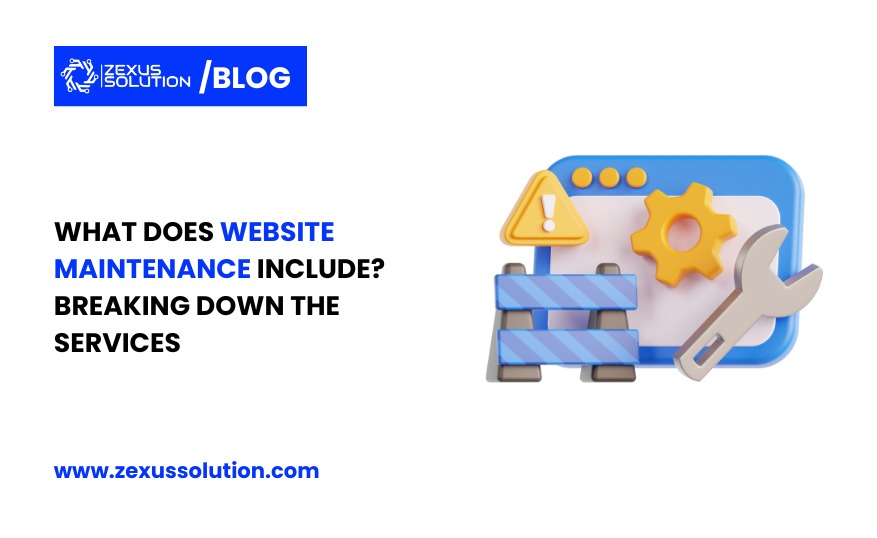Table of Contents
Imagine you walked across a beautifully designed boutique on a busy street. The colors and the window display caught your attention, and you walked in. Once you stepped into the layout, the atmosphere, the convenience, and the customer service shaped your experience, and you formed an impression of that boutique. This is how websites work. They can be considered an online store that forms your customers’ first impression.
Just as a physical store’s ambiance, layout, and staff can make or break a customer’s experience, a website’s design, usability, and engagement determine how customers perceive your business and whether they’ll stick around.
Now if that boutique looks beautiful but when customers walk in it is cluttered, hard to navigate, or unwelcoming, they will walk out and probably not return. The same thing happens when your website loads slowly or is hard to navigate. That’s why developing and designing a website are just the first steps—web application maintenance services are just as crucial.
What Does Website Maintenance Include?
Website maintenance services include many things to ensure that a website is secure, user-friendly, and perfectly updated. Here is a breakdown of what a website maintenance includes:
1. Security Updates and Patches

The Internet is constantly changing, so the nature of cyber threats is always evolving. Websites that use old software, plugins, or themes are highly vulnerable to attacks. You will require updates for security purposes, ensuring the protection of sensitive information and preventing unauthorized access.
It involves:
- Apply patches to the CMS. The CMSs include a blog like WordPress, perhaps Joomla, or Drupal.
- Keep third-party plugins and themes updated. Installing a firewall as well as a malware scanning tool.
- Confirm the SSL certificate is on and correctly set up to encrypt data exchanges.
- Scan for security breaches and update known vulnerabilities.
2. Performance Optimization
A fast-loading and responsive website is critical to user satisfaction and SEO. Over half of the bounce rate is from the slow loading of websites as users leave before the whole page loads. Search engines prefer fast sites as well.
It involves:
- Minifying the CSS, JavaScript, and HTML files to improve the load time.
- Using the Content Delivery Networks (CDNs) to distribute the content faster on the global servers.
- Browser caching to speed up the load times for return visitors.
- Server performance and bandwidth usage should be monitored and optimized.
3. Content Updates and Freshness

Regular updates to your content ensure that your website is fresh and interesting. Old content can damage your credibility and affect your ranking in the search engine result pages. Some of the best website maintenance companies provide fresh content that motivates users to come back to your site.
It involves:
- New articles or blog posts with a date of publication.
- Updating the latest services or products on the page.
- Information, statistics, or facts are reworded.
- Old images, infographics, and banners also need to be updated from time to time.
- Managing customers’ reviews, testimonials, and other user-generated content.
4. Bug Fixes and Troubleshooting
Websites may sometimes show errors or glitches over a long period. This will damage the user experience. Some links are broken, while some plugins are faulty, and sometimes it may be due to coding errors. This will make the users lose interest and destroy the business’s reputation as well.
It Involves:
- Checking the site for broken links and repairing 404 errors
- Compatibility issues of plugins with the core website software.
- Layout problems: Fix issues where items are not showing on mobile devices or browsers.
- User reports bugs, such as a failed submission of forms or checkout
- Correct errors in the code; make it faster and more efficient.
Backup and Disaster Recovery
Application maintenance best practices include backup and recovery of data. Backups protect your data. When your site goes down, hackers try to get in, or a technical failure appears, the old backup is saved. This way you can have your site up quickly and not lose data.
It Involves:
- Schedule internal backups to automate daily, weekly, or monthly.
- Ensure full site components are covered: database, files, media, and configurations.
- Backups should be kept in a safe place: cloud storage external drives, or even a lot of spare drives that others aren’t using.
- Testing recovery procedures to be sure that backups can be restored smoothly.
- Disaster recovery planning fully, ensures business continuity if there are significant problems.
SEO Maintenance

SEO is not a one-time task. As search engine algorithms change from time to time, you need to regularly tweak if you want to see your website ranking higher than before. A website that is not optimized well may end up “lost,” which translates to reduced traffic.
It Includes:
- Optimizing meta titles, descriptions, and headings using relevant keywords.
- Assuring there are no broken internal links and redirecting all dead pages.
- Adding alt text to images, and labeling media objects correctly for SEO.
- Monitoring site speed, mobile-friendliness, and other core web vitals that affect rankings.
- Doing keyword research regularly and updating content based on the intent of the search.
Mobile Responsiveness
As more and more users visit websites on their phones, your site should be responsive. In fact, Google displays mobile-friendly websites at higher positions in search results so optimal mobile responsiveness is integral to both usability and SEO.
It Includes:
- Testing the website on all kinds of mobile devices and screen sizes to ensure proper functionality.
- Adjusting layout, button, and form to be easily accessible from small screens.
- Scaling of the media elements: images, and videos should be scaled accordingly without distortion.
- Optimizing the touch elements so that navigation on mobile devices becomes easy.
Plugin and Integration Updates
The majority of websites rely on third-party plugins for enhanced functionality, such as payment gateways, email marketing integrations, or social media feeds. The updates of the plugins are required to ensure compatibility with the core website software, in addition to preventing security breaches.
It Includes:
- Maintenance of plugins for compatibility.
- Search for new integrations or features that can improve functionality on the website.
- Remove unused or deprecated plugins to improve the performance of the site.
- Testing new releases of plugins in a development environment to avoid breaking the site.
Analytics and Performance Monitoring

Regular monitoring will enable you to understand how people interact with your website, what performs, and what should be changed. Analytics help you discover traffic sources, user behavior, and conversion rates so you can make informed decisions.
It Includes:
- Setup and analysis of Google Analytics or other analytics platforms.
- Monitoring traffic patterns, page views, bounce rates, and session duration.
- Follow the type of behavior users conduct, such as which pages are visited the most, or where the users drop off.
- Setup goal tracking for conversions such as form submissions and sales
- Updating content, layout, and/or marketing campaigns frequently with and according to data analytics.
Database Maintenance
All information about users, posts, and media files is stored in the database of a website. With time, you may realize that your database is filled with data it does not need, which will slow down your website or make it crash more easily.
It Includes:
- Cleans up spam comments, post revisions, and unused media files.
- Optimizes database tables to make the site load faster.
- Removes old or expired content no longer needed.
- Limiting access to the database while encrypting information stored in it.
Conclusion: The Lifelong Commitment to Website Success
Maintaining a website is absolutely important for the reason that it needs to be kept safe, efficient, and engaging for the users. Like that shop, in reality, wants to create an inviting atmosphere on the virtual platform, your site also requires consistent maintenance in order to be a good user experience. A well-structured website maintenance checklist will keep you on track as you cover security updates to performance optimization.
The importance of website maintenance is to keep your online appearance working, increase your rankings on the search engine, and generate trust among your target audience. When managing web applications, following best practices and web app maintenance tips can enhance the user experience while minimizing downtime. Staying updated with the latest trends in web app maintenance, such as automated monitoring and AI-driven solutions, ensures that your website remains competitive in an ever-evolving digital landscape.
Ultimately, the best way to ensure your site keeps running at a profit is to continually invest in your site as an ongoing strategy for long-term success.



Add a Comment